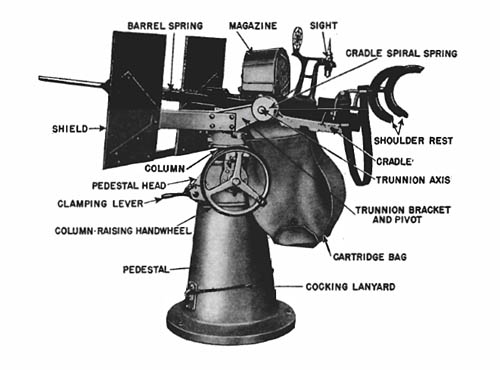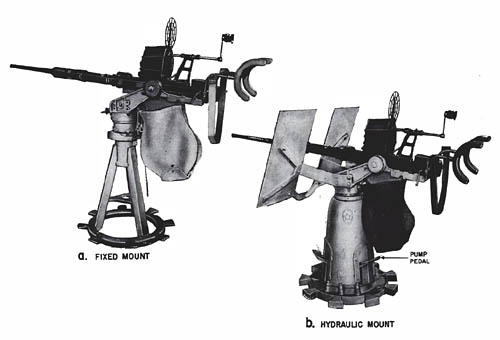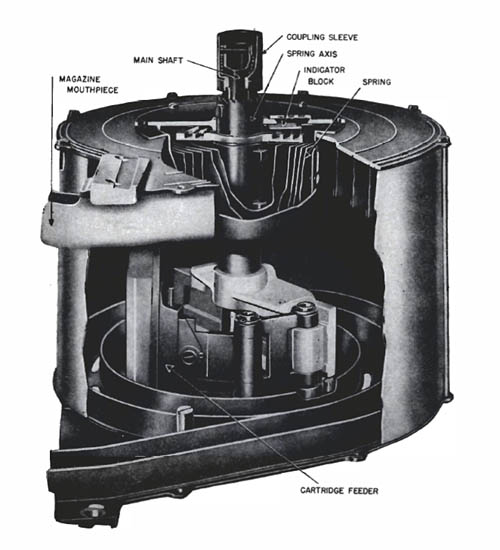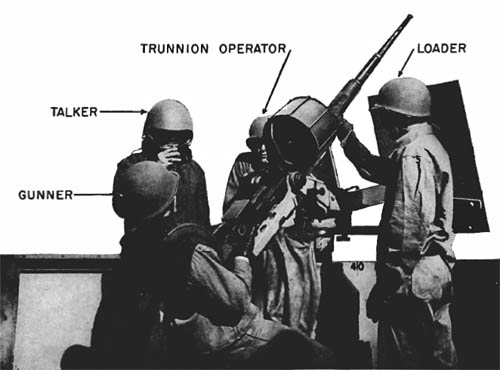Description of 20 mm guns and mounts deployed on U.S. naval vessels, on merchantmen, and at many shore stations in WWII from Naval Ordnance and Gunnery, NAVPERS 16116, Bureau of Naval Personnel, Training Division, May 1944.
20 MM. GUN AND MOUNTS
7C1. General. The 20 mm. gun assembly, shown in figure 7C1, is an AA machine gun mounted on a pedestal-type. free-swinging mount. The mount is so arranged that the trunnion height can be adjusted for the convenience of the gunner when the gun is used at different angles of fire. The elevation limits are 5° depression and 87° elevation. There are no limits in train.
The gun is designed for automatic firing only and, like other automatic guns, it uses some of the force developed by the explosion of the propellant charge to eject the empty case, cock the gun, reload, and fire the next round. It embodies, however, certain features of gun design which are not found in other automatic and semi-automatic guns. The most important of these are:
1. The gun barrel dues not recoil.
2. The breechblock is never locked against the breech and is actually in motion at the moment the gun is fired.
3. There is no counterrecoil brake, the force of counterrecoil being checked by the explosion of the following round of ammunition.
The 20 mm. fires fixed ammunition which is fed into the gun from a magazine having a capacity of 60 rounds. The cyclic rate is about 450 rounds per minute. When the normal time required to change magazines is considered, the rate will vary between 250 and 320 rounds per minute depending upon the skill of the gun crew. The projectile used is a high-capacity type and is fitted with an impact-type nose fuze. Usually every other projectile or every third projectile in the magazine carries a tracer.
The 20 mm. gun is being used extensively on all classes of naval vessels, on merchantmen, and at many shore stations. It has been designed for and is particularly effective against aircraft targets at ranges up to about 2,000 yards. For this purpose it has almost entirely replaced the caliber .50 machine gun, principally because the heavier 20 mm. projectile with its high-explosive charge causes much more damage than the non-explosive caliber .50 projectile. The gun may also be used against lightly-armored targets.
7C2. Mounts. There are several kinds of pedestal-type, free-swinging mounts in use. The major difference between these mounts is in the method of adjusting the trunnion height. The mechanical mount shown in figure 7C1 is the one which is most widely employed at the present time.
The fixed pedestal is bolted to the deck. The pedestal head, through which the column rises, is so mounted that it can be rotated around the top of the pedestal and locked in any desired position by means of the clamping lever. The column-raising handwheel, mounted on the pedestal head, is used to raise and lower the column. By this means the trunnions can be raised about 15 inches to better position the gun for the gunner when firing at elevated targets.
The trunnion bracket and pivot is free to rotate around the top of the column on ball bearings, and there are no limits to this training motion. This part supports the shield, the cradle spiral spring, and the cradle. The gun is carried in two grooved slides in the cradle, and is held in place by a bolt. The cradle spiral spring, mounted around the left trunnion, as one end attached to the trunnion and the other to the spring case. This spring functions to counterbalance the weight of the gun.
From the above description it is evident that the gunner, strapped to the aft end of the gun, can swing the gun to any position within elevation limits, and that the trunnion height can be adjusted for his convenience and comfort. As the gun is moved in train, the column-raising handwheel can also be moved into position for easier operation.
Two other mounts which are used to a limited extent are shown in figure 7C2. The fixed mount, so called because it does not have an adjustable trunnion height, has a higher pedestal than the mechanical mount. The gunner is provided with a circular stepped platform around the mount to enable him to utilize the full range of elevation and depression available. The elevation limits are the same as for the mechanical mount and there is no limit in train.
The hydraulic mount has a foot-operated hydraulic mechanism to raise and lower the column. The three equally spaced pedals around the pedestal are connected to the hydraulic pump and control valves within the pedestal. Any one of these pedals can be pumped to raise the column or fully depressed when the column is to be lowered. The column can be raised 24 inches, and the gun elevation limits are 15° depression and 90° elevation. There are no limits in train.
…
7C13. Ammunition. The 20 mm. gun uses fixed ammunition which is designed to give an I.V. of 2,725 f.s., and a maximum horizontal range of about 5,000 yards. The following projectiles are used: (1) high-explosive bursting charge with tracer, (2) high-explosive bursting charge without tracer, (3) blind loaded with tracer, (4) blind loaded and plugged, and (5) incendiary. The high-explosive bursting charge is either tetryl or a high explosive known as pentolite. The tracer charge is effective for about 3¾ seconds duration. It occupies about one-half of the projectile cavity, and hence projectiles with tracers carry approximately one-half as much bursting charge as those without tracers.
The projectiles are equipped with a simple impact-type nose fuze. On impact a closing disk is displaced into the fuze body and an air column within is instantaneously compressed and forced through an inner disk, thus heating the air column. The heated air ignites a small pellet of lead azide which in turn sets off pressed tetryl in a detonator, exploding the burster charge. The 20 mm. projectiles do not have the self-destructive arrangement found in 40 mm. ammunition.
7C14. Magazine. A sectional view of the magazine is shown in figure 7C15. The spring is hand wound from the outside and its tension is indicated on the indicator block. The cartridge feeder, driven by the spring, exerts a pressure on the innermost round and tends to force the cartridges around the spiral guides and out of the magazine mouthpiece. The lips of the magazine mouthpiece are partly closed so that a round can pass through only by being pushed out longitudinally at right angles to the direction of the pressure from within. A gap is cut in the forward end of the mouthpiece to allow the rounds to slide in or out. The magazine has a capacity of 60 rounds; a new-type magazine holds 100 rounds.
7C15. Gun sights. Tn the past, fire control of the 20 mm. gun has been primarily by means of tracers, ring sights having been used to get on the target. However, the present tendency is to rely upon the Mark 14 sight, supplemented by spotter’s observations of tracers. At present, then, available sights for this weapon include the following:
1. The Mark 14 sight, a gyroscopic sight mechanism which automatically computes the lead angle necessary for different speeds and motions of the target. The gunner sights on the target through a small window through which luminous crosslines are projected. The crosslines are kept on the target, and, as the gun swings following the target’s movement, the crosslines are offset to give the proper lead angle for the gun.
2. The older cartwheel sight, or peep and ring sight, consists of a rear peep and a forward circular grid, with concentric rings to indicate the amount of lead necessary for different target speeds. This sight enables the gunner to get on the target before opening fire; thereafter, tracer control normally is used. Several types of ring sights have been developed.
7C16. Gun crew. The gun crew for the 20 mm. mechanical mount consists of at least three men (four if the Mark 14 sight is used):
1. The gunner, who is strapped to the shoulder rests on the after end of the gun elevates, trains and fires the gun.
2. The trunnion operator, who raises and lowers the column on which the gun is mounted.
3. The loader, who places loaded magazines on the gun and unships them when they are empty.
4. The range setter, who observes the effects of fire and changes range setting on the Mark 14 sight.
The gun crew may also include ammunition passers, who hand loaded magazines to the loader and take the empty magazines after they are removed from the gun. The number of ammunition passers used depends upon the location of the ready boxes.
The gun is entirely free-swinging, and thus can be elevated or trained merely by the movement of the gunner’s body. The trunnion operator stands to the left of the gun, faces the gunner, and keeps his back to the shield on the mount. He moves his handwheel around the pedestal of the mount as the gunner swings the gun in train. He watches the gunner’s knees and adjusts the gun height so as to keep the gunner’s knees slightly bent during firing. The loader stands to the right of the gun and, operating the magazine catch lever, removes the spent magazine and replaces it with a filled one. A gun and operating crew is shown in figure 7C16.
…
7C19. General data.
Caliber 20 mm. (.79 inch) Length of barrel (calibers) 72 (approximately) Limits on elevation (mechanical mount) 5° depression and 87° elevation Arc of train unlimited Firing rate (assuming continuous ammunition supply) 450 rounds per minute Firing rate (considering time to change magazines) 250-320 rounds per minute Magazine capacity (rounds) 60 (100) Muzzle velocity (f.s.) 2,725 Maximum range (36° elevation) approximately 5,000 yards Commence firing range (with Mark 14 sight): High elevation 1,000 yards Horizontal 2,000 yards Weights: Gun 141 pounds Mount (mechanical) 1,578 pounds Magazine—loaded 63 pounds Magazine—unloaded 31 pounds Round of ammunition approximately 0.5 pound














Brings back memories
I crewed one of these guns back in the day in the Navy
These guns could administer a world of hurt. Back in the days before aquaflage